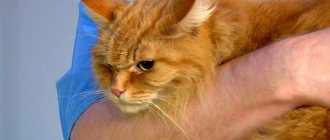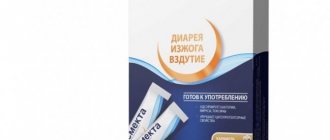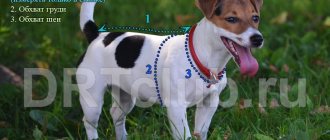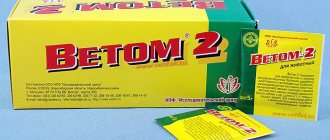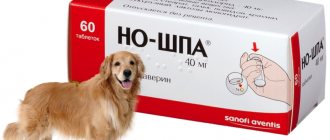What is colitis in dogs
The term “colitis” is a general medical one, and not a purely veterinary one. Literally, it means inflammation of the large intestine, more precisely, its mucous membrane (“kolon” translated from ancient Greek - large intestine, the suffix “it” from the Latin “itis” - the traditional designation of the inflammatory process in a particular organ).
The main function of the large intestine in a dog’s body is the formation of feces from the remains of undigested food. In addition, here, in the lower intestine, part of the process of reabsorption of water takes place and the absorption of certain nutrients that enter the stomach as part of the feed is completed. It is clear that an organ characterized by such high physiological activity is susceptible to various pathologies, which include: motor disorders, neoplasms and functional disorders. But the most common reaction to an external or internal irritant is inflammation.
Types of disease
Like any other inflammatory process, colitis is a collective concept. Classification of pathology is possible according to various criteria, which, in particular, include the localization of the source of the disease, the cause that caused the inflammation, the form of manifestation of clinical symptoms, the nature of the course, etc.
Depending on the stage of development of the disease, colitis in a dog can be catarrhal, ulcerative and atrophic. The main characteristics inherent in each of these varieties are given in the table:
| Type of colitis | Clinical picture |
| Catarrhal | The inflammatory process is at the initial stage. The mucous membrane looks swollen and reddened, but the animal’s general well-being is still almost unaffected, with the exception of mild symptoms of malaise: lack of appetite, rumbling in the lower abdomen, difficult or frequent bowel movements, increased fatigue, and sometimes the appearance of a gray coating on the tongue. |
| Ulcerative | A complicated form of the disease, a direct result of the lack of timely treatment of the catarrhal stage. Deep damage to the intestinal mucosa is accompanied by the appearance of ulcers and areas of dead tissue. The main clinical sign is bloody spots in the stool. Prolonged diarrhea can also cause dehydration of the body and a general deterioration in the pet's well-being. |
| Atrophic | An advanced form of inflammation, accompanied by the onset of destructive processes in the intestine, pathological changes in tissue structure, stenosis (narrowing of the lumen) of the colon, which can sometimes cause complete intestinal obstruction and atrophy. |
According to the form of the disease, colitis can be acute or chronic.
Spicy
The acute form of colitis is characterized by a pronounced clinical picture, when problems with the dog’s intestines are completely obvious not only to the doctor, but even to the owner of the animal. It looks like ordinary food poisoning: the dog begins to have diarrhea, which may be accompanied by vomiting, fever, increased body temperature, and lethargy. The abdomen is usually painful, especially in the lower part. In this phase, in addition to the large intestine, the inflammatory process can also affect the small intestine and even the stomach, thus, symptoms of colitis are present in the dog in combination with clinical signs of gastritis and enteritis.
Important! Simultaneous inflammation of three parts of the digestive tract - the stomach, small and large intestines - is medically called gastroenterocolitis.
In acute colitis, a dog may have bowel movements more than 10 times a day; the stool is very liquid, sometimes mixed with blood, mucus, foam and fragments of undigested food.
Chronic
If the cause that caused acute colitis in a dog has not been completely eliminated, the vivid symptoms of the disease may fade over time, including under the influence of internal protective mechanisms and externally the animal’s condition seems to normalize, although in reality a complete recovery does not occur. From time to time, sometimes even for no apparent reason, your pet develops diarrhea, pain and rumbling in the stomach, and other symptoms of intestinal disorder. This clinical picture is characteristic of chronic colitis.
The disease is accompanied by a general weakening of the functions of the digestive system, which is often expressed in loss of appetite, decreased muscle mass, fatigue and periodic exacerbations, i.e., conditions characteristic of the classic form of colitis.
Types of colitis
In veterinary medicine, acute and chronic forms of the disease are distinguished. According to the nature of the damage to the mucous membrane, experts distinguish catarrhal, atrophic and ulcerative colitis.
Spicy
The development of acute colitis is characterized by pronounced irritable bowel syndrome. The dog has loose stools mixed with mucus and blood. The frequency of bowel movements can be 8 - 10 times a day. The animal experiences severe pain and completely refuses food. Body temperature can increase by 0.5 - 1 degree.
Chronic
Chronically current colitis is characterized by frequent stool disorders. The animal’s loss of live weight progresses and signs of dehydration are observed. A rise in body temperature, as a rule, is not observed. The animal becomes lethargic and loses its appetite.
Ulcerative
A severe form of diffuse inflammation of the colon mucosa is ulcerative colitis. The disease is accompanied by bloody diarrhea, copious discharge of mucus and blood during tenesmus, and rapid exhaustion of the pet. The disease is characterized by periodic vomiting. The animal's extraintestinal symptoms progress: anemia of the visible mucous membranes develops, and the electrolyte balance in the body is disturbed.
A complication of the peptic ulcer form of the disease is often intestinal bleeding, intestinal perforation, which requires immediate surgical intervention.
Veterinary experts consider autoimmune disorders to be the causes of the development of ulcerative colitis. Boxers and German Shepherds have a genetic predisposition to what is called histiocytic ulcerative colitis. The disease affects young animals under 2 years of age. The clinical picture is similar to ulcerative inflammation. The animal experiences pain when defecating. Often the pathology is accompanied by vomiting.
Why does inflammation occur?
There are several main reasons for the development of colitis in dogs, and, as already mentioned, this criterion is the basis of one of the classifications of the disease.
In particular, colitis can be caused by a direct effect on the intestines of such irritating factors as:
- pathogenic microflora - bacteria, viruses, fungi;
- protozoan parasites - in particular, nematodes and other tapeworms that irritate the intestinal walls can pose a huge problem for the dog’s body;
- chemical poisons, acids, household chemical products and other toxins;
- antibiotics and other potent drugs that destroy the natural intestinal microflora;
- fatty, spicy, sour, salty, sweet, smoked, fried foods;
- an abundance of food or low-quality products (stale meat, an abundance of raw vegetables, etc.).
Did you know? The longest worm in the world is the tapeworm Diphyllobothrium Saturn, whose body length reaches 12 m. This helminth usually parasitizes in the intestines of fish, but if the rules of sanitary processing of products are not followed, it can infect both humans and dogs.
In addition, colitis can develop against the background of stress, trauma (including due to a foreign body entering the intestine) or as a specific type of allergic reaction. Sometimes the cause of intestinal inflammation can be the appearance of tumors in it, both benign (for example, polyps) and malignant (adenocarcinoma).
But there are several types of colitis, the exact causes of which are still unknown to scientists, which greatly complicates both the diagnosis of the disease and the selection of adequate treatment.
Lymphocytic-plasmacytic colitis
Lymphocytic plasmacytic colitis is a fairly common pathology among dogs. A characteristic feature of the disease is the penetration of lymphocytes and specific blood plasma cells into the intestinal mucosa, as a result of which, due to the reaction of the lymphoid tissue to these components, inflammation occurs. Despite the frequency of reported cases, the specific cause of the development of the lymphocytic-plasmacytic form of intestinal damage has not been fully studied.
Important! Lymphocytic
–
plasmacytic colitis is often called an idiopathic disease, that is, a disorder that occurs for an unknown reason.
This type of inflammation usually occurs in a chronic form, but its first symptoms usually appear in dogs in the second half of life. It is generally accepted that we are talking about an autoimmune pathology, when the body’s defenses for some reason begin to attack its own cells and tissues. In defense of this version, it can be said that the disease has a clearly defined breed predisposition. Thus, more often than in other breeds, lymphocytic-plasmacytic colitis occurs in Basenjis, German shepherds, Shar-Peis, as well as Irish soft-coated wheaten terriers of both sexes.
Eosinophilic
Another type of colitis with a completely unclear nature is called eosinophilic. Just as in the case described above, the inflammatory process in the large intestine in this form of pathology is associated with the penetration of blood particles into it, but this time we are talking about eosinophils - a special type of leukocytes that the immune system begins to actively produce in response to parasitic infection. Sometimes, however, eosinophils react to substances mistakenly taken for enemies, thereby causing allergies.
Thus, it is assumed that the root cause of eosinophilic colitis is protection from protozoan parasites that have entered the dog’s body, or an allergic reaction to a particular food product. In addition, this type of inflammation of the large intestine in a dog can also occur after taking certain medications (for example, antibiotics). Another possible reason is weakened immunity.
Did you know? In 1932, an American gastroenterologist from a large family of Jewish immigrants, Barril Bernand Krohn, first discovered in his patient and described in detail the granulomatous form of intestinal inflammation, thereby perpetuating his name. This disease in humans is medically called Crohn's disease.
Granulomatous
Granulomatous colitis is a rare disease, but very serious and, unfortunately, little studied. The main feature that distinguishes it from other types of inflammation of the large intestine is that the pathology is accompanied by the formation of special nodular seals on the walls of the mucous membrane - granulomas, consisting of abnormally dividing cells. Thus, with the granulomatous form of the disease, not just redness, swelling or ulceration of the intestinal walls occurs, but damage to their entire thickness.
Unlike many other types of colitis, the granulomatous form is considered incurable, although complex drug therapy helps to significantly reduce the symptoms of inflammation. The main danger of the disease is that, in the absence of treatment, the process of atypical cell growth begins to spread its effect to neighboring tissues, and small nodules, growing, sometimes transform into malignant neoplasms.
Histiocytic
In the histiocytic form, inflammation of the large intestine is provoked by histiocytes penetrating into it - wandering cells of loose connective tissue. Histiocytes are an integral part of animal immunity, since their main function is to destroy foreign particles that enter the body. Thus, the nature of histiocytic colitis appears to be in the realm of autoimmune reactions, as is the case with the thymphocytic-plasmocytic and eosinophilic form.
Important! Histiocytic colitis, like other autoimmune forms of the disease, cannot be completely cured.
However, unlike the two listed varieties, this disease always causes through-and-through damage to the intestinal mucous membranes, so its correct (full) name is histiocytic ulcerative colitis.
A special predisposition to pathology in Boxer dogs has been noted, and while the types of inflammation listed above more often affect mature animals, the histiocytic form is more typical for young individuals (up to 2 years old) and even puppies.
Infectious
Infectious colitis, as its name suggests, develops against the background of progressive damage to the dog’s body by one or more harmful microorganisms. These may include, in particular:
| Pathogen type | Examples |
| Bacteria | E. coli, clostridia, salmonella, campylobacter |
| Viruses | paramyxoviruses, parvoviruses, influenza (intestinal strain), coronaviruses, reoviruses, adenoviruses |
| Fungi | candida, histoplasma |
| Endoparasites | amoeba, lamblia, balantidia, trichomonas |
| Helminths | roundworms (nematodes), tapeworms (cestodes), flukes (trematodes) |
Allergic
Food allergies in dogs, unlike in humans, occur quite rarely and almost never manifest themselves in the form of intestinal disorders. And yet, colitis may well be of an allergic nature. However, intolerance to a certain type of food should not be confused with an allergic reaction. For example, if a dog reacts with severe diarrhea or bloating to an abundance of fatty foods, being treated to a cake with cream, or another type of questionable treat, this is not an allergy. The classic example of allergic (autoimmune) colitis is eosinophilic; in certain cases, the same category includes lymphocytic-plasmocytic and histiocytic forms of inflammation.
Did you know? The source of salmonellosis is not eggs, as many people think, but chicken droppings. It takes bacteria on the surface of the egg from several hours to several days to penetrate the shell.
Inflammatory causes of appearance
The causes of colitis in dogs can vary. Veterinarians have created a special classification, according to which they look at what became the causative agent. The course of the disease will depend on this.
Colitis is often caused by inflammatory processes in the intestines. In this case, the disease takes different forms:
- Lymphocytic-plasmocytic. This form has not yet been fully studied by specialists, so animals that become ill with it, unfortunately, do not live long. It is characterized by the occurrence of a pathological reaction of the immune system in the body. Also, after some time, the number of plasmacytic cells and some blood components, in particular lymphocytes, increases in the mucous membrane.
- Histiocytic. This form is more often observed in dog breeds such as boxers, bulldogs and others with a strong build. Experts have noticed that this process is most likely of autoimmune origin, but it still causes inflammation.
- Granulomatous. A clear example of the fact that animal diseases are very similar to human pathologies. Granulomatous colitis is very similar in symptoms to Crohn's disease. The pathology is characterized by an inflammatory process caused by the appearance of foreign cells in the body, namely, in the walls of the large intestine.
- Eosinophilic form. The cause of the inflammatory process in the walls of the colon and rectum is an increase in eosinophil cells in the body. They are formed as a response to a parasitic infection, and can also indicate an animal’s allergies.
How do symptoms appear?
The clinical picture of colitis in general is quite obvious. The main symptom of inflammation of the large intestine in a dog is a frequent urge to defecate and very loose, almost watery stools. In addition, depending on the type, form and stage of development of the pathology, the pet’s condition is characterized by additional signs such as:
- bloating, flatulence;
- rumbling, gurgling sounds in the intestinal area;
- vomit;
- severe belching, especially after eating;
- unpleasant odor from the mouth;
- cardiopalmus;
- increase in general body temperature (usually slight, up to subfebrile);
- fever, chills;
- refusal to eat;
- dehydration;
- gray plaque on the mucous membrane of the tongue, gums, and oral cavity;
- abdominal pain;
- severe muscle tension during bowel movements;
- an admixture of blood, mucus, undigested food in the stool (a direct sign that the inflammation is localized specifically in the large intestine);
- change in the color of stool (usually they become lighter and often foam);
- manifestation of strange taste preferences - greedy eating of grass, sand, stones, feces and other unusual objects;
- weight loss;
- general weakness, lethargy, apathy.
How is the diagnosis carried out?
To diagnose an acute form of colitis, it is usually enough for a veterinarian to conduct a general clinical examination of the animal and collect a detailed history. However, the correct treatment can be prescribed only if the exact cause of the inflammation (or at least its type) is established, as well as the degree of damage to the mucous membranes (catarrhal, ulcerative or atrophic). For this purpose, additional studies are usually prescribed, in particular:
- clinical blood test;
- blood test for parasites;
- general urine analysis;
- bacterial culture;
- X-ray examination of the peritoneum;
- Ultrasound of the intestines;
- video colonoscopy or laparoscopy (diagnostic examination of the intestine using an endoscope, which is inserted through the anus or through a small incision in the abdominal wall).
Did you know? No one doubts the intellectual abilities of dogs, but the fact that this animal is able to drive a car seems like a miracle. Meanwhile, in New Zealand, an experiment was conducted that was successfully completed by three pets at once - they had to drive a given distance in a straight line and make a turn in the right place.
A careful analysis of the results will allow the veterinarian to detect:
- pathogenic microflora and a specific type of infectious agent;
- foreign body in the intestine;
- compactions, granulomas, tumors and other neoplasms;
- the presence of ulcers and necrotic areas of tissue;
- changes in the thickness of the intestinal walls, squeezing it with feces, decreased patency, volvulus, etc.
Diagnostics
Therapy primarily depends on the form of the disease. During diagnosis, a specialist must not only identify the presence of intestinal inflammation, but also determine its type. If mucous or bloody-mucous inclusions are found in feces, it means that the pathological process is localized in the large intestine.
Palpation can reveal pain, but pain is not always present with colitis. If colitis develops against the background of another systemic disease, then the results of blood and urine tests provide comprehensive information. In other cases, they only confirm the presence of inflammation in the body.
Your veterinarian may order a stool sample for laboratory testing. The analysis identifies microscopic pathogenic fungi and parasites living in the gastrointestinal tract. Under certain conditions, bacterial culture is recommended, with the help of which the causative agent of infectious colitis can be determined and a suitable antibacterial agent can be selected.
Using an x-ray of the peritoneum and ultrasound examination of this area, it is possible to identify most possible disorders:
- the presence of foreign objects in the lumen of the colon;
- squeezing by feces;
- thickening and hardening of the intestinal wall;
- volvulus;
- increase in the size of lymph nodes, etc.
Treatment of colitis in dogs
Treatment of colitis in dogs, as a rule, is a complex of measures combining drug therapy with a gentle diet. Surgical intervention for inflammation of the large intestine is required only in the most exceptional cases (this primarily concerns granulomatous, histiocytic ulcerative, fungal colitis, as well as various neoplasms in the lesion), therefore, as a rule, it is quite possible to treat a dog at home, guided by general recommendations of a veterinarian.
With the help of drugs
Simple forms of colitis are treated symptomatically, while autoimmune types of inflammation require the use of more complex therapy.
Depending on the cause of the pathology, its location, the severity of the animal’s condition and other important factors to normalize the animal’s condition, the veterinarian can use the following categories of drugs:
| Drug category | Examples of trade names | What is it prescribed for? |
| General restoratives, rehydration therapy | Potassium or sodium chloride, glucose, Ringer's solution | Restoring water-salt balance, preventing dehydration |
| Enterosorbents | Enterosgel, Polysorb | Normalization of intestinal microflora |
| Anti-inflammatory drugs | Sulfasalazine, Mesalazine | Relief of acute inflammatory process |
| Antibiotics, antimicrobials | Enrofloxacin, Kanamycin, Biseptol, Sinulox, Metronidazole, Tylosin, Febendazole | Destroying pathogenic bacteria in the intestines |
| Medications to improve colon motility | Loperamide, Lopedium, Imodium, Enterobene | Elimination of diarrhea |
| Antispasmodics | No-shpa, Baralgin, Papaverine | Relieves muscle tension in the large intestine and alleviates painful conditions |
| Preparations, iron content | Ferroklyukin, Ferran | Elimination of anemia |
| Corticosteroids | Flixotide, Prednisolone | Treatment of allergic colitis |
| Immunosuppressants | Azathioprine, Imuran, Cyclophosphamide, Enoxan, Cyclophosphamide | Suppression of atypical immune response in complex forms of idiopathic colitis. Can also be prescribed for tumors of various natures |
How to feed a sick dog
Any pathology of the gastrointestinal tract requires the use of a strict diet at the rehabilitation stage, but if intestinal inflammation is accompanied by general intoxication of the body, stabilization of the animal’s condition requires the complete exclusion of any food during the first stage of treatment.
Important! In case of acute poisoning, it is useful for the animal to fast for 24 to 48 hours, however, during this entire time the pet must receive a large amount of fluid in order to avoid dehydration - the most dangerous condition that occurs against the background of an intestinal disorder.
After the painful diarrhea subsides, the dog is gradually given low-fat and easily digestible food - viscous rice porridge with the addition of boiled dietary meat. In this capacity you can use chicken breast, turkey, rabbit. Butter, eggs and dairy products should be excluded from the diet for a while, the same goes for raw vegetables and fruits.
In case of intestinal disorders, in addition, bones, “heavy” porridges (millet, oats, buckwheat), canned fish or meat, strong broths, as well as any foods that can cause bloating (for example, cabbage) are contraindicated. Floury, sweet, fatty and salty foods should be absent from a dog’s diet at any time, regardless of the pet’s health status.
If there are any doubts regarding the admissibility of a particular product during the treatment of colitis. It should be assumed that the diet during this period must meet three main criteria: nutritional value, easy digestibility and hypoallergenicity.
Meals during the rehabilitation period should be frequent and divided: instead of the usual 2-3 times a day, the number of meals can be increased to 4-5, adjusting the size of the single serving accordingly.
As a basis for the diet, you can also use ready-made mixtures specially designed for dogs suffering from gastrointestinal pathologies. Such products are available in the range of many holistic, premium and super premium food manufacturers, and with the help of a veterinarian they can be selected according to narrower criteria:
- for puppies or adult animals;
- for large or small breeds;
- for sterilized animals;
- hypoallergenic mixtures, etc.
After a few weeks, if the pet’s condition has recovered, it can be transferred to a regular diet.
Did you know? The heaviest dog in the world weighed 155.6 kg. This record was recorded in 1989 by an English mastiff named Zorba.
Prevention
When preventing colitis in dogs, you should carefully monitor your pet:
- so that he does not eat feces and garbage on the street,
- prohibit children, acquaintances and friends from feeding the “starving poor thing”,
- keep medications and detergents out of reach,
- close the refrigerator tightly and do not leave food on the table,
- while taking out the trash.
In order for a dog to be healthy and happy, the owner must take care of its health. After all, our pets are like little children, sticking their noses in wherever they go. So even very attentive owners will not always be able to keep an eye on their pet.
In particular, symptoms of colitis in a dog should not be ignored. If any suspicious external manifestations are detected in the animal, you should immediately take it to a veterinary clinic. Here, with the help of modern equipment, the veterinarian will give an accurate diagnosis of the disease and advise on the treatment process. Another method for determining the symptoms of colitis is an abdominal x-ray. Using this method, it is possible to detect in the body:
- foreign bodies,
- volvulus,
- inflammatory processes,
- changes in the size of tissues and lymph nodes,
But x-rays cannot provide accurate information about ongoing processes. Due to flatulence. A comprehensive diagnosis is required.
Recovery prognosis
In case of acute colitis caused by poisoning or an infectious component, symptomatic drug treatment associated with short fasting usually gives a positive result quite quickly, and after a few days the dog’s well-being is completely normalized. If intestinal inflammation has acquired a chronic form or is caused by idiopathic autoimmune causes (lymphocytic-plasmacytic, eosinophilic, granulomatous, histiocytic forms), complete recovery may never occur, but this does not mean that the animal is doomed. In such situations, labor-intensive work aimed at correcting the diet and selecting a diet that will reduce the frequency of clinical manifestations of the disease to a minimum comes to the fore.
The second factor, after proper nutrition, to improve the condition of a pet with autoimmune forms of colitis is the identification and elimination of the allergen that provokes an atypical reaction of the digestive tract.
Important! Relapses of chronic colitis in dogs are almost always the result of a departure from the doctor’s instructions regarding the animal’s diet and an attempt to treat the pet with something
–
something “tasty” from the human table.
Treatment
Treatment is carried out based on the nature of the pathology. If a dog has acute colitis, then doctors prescribe a two-day fast, during which the dog gets rid of diarrhea and possible overeating.
Next, a special diet is prescribed, during which the animal fills its body with nutrients, thereby gaining back the weight lost due to the disease. It is important that the dog does not take anything fatty or fried while eating. It is better to diversify your diet with vegetable oils - they will help speed up the healing process of the affected organ membranes. It is recommended to boil chicken, turkey and rabbit meat for animals.
It is forbidden to buy a variety of food for your dog at this time, because taking them may worsen the body’s condition. This is due to the fact that they contain many chemical elements, digestive additives and dyes. And during a diet they are prohibited.
If a dog has chronic colitis, then the animal is given enemas. It is difficult to cure an animal if the dog has ulcerative colitis. This is due to the fact that many drugs turn out to be simply useless, and the only one that really helps is Enrofloxacin. This is a very rare medicine and is not sold in all pharmacies.
